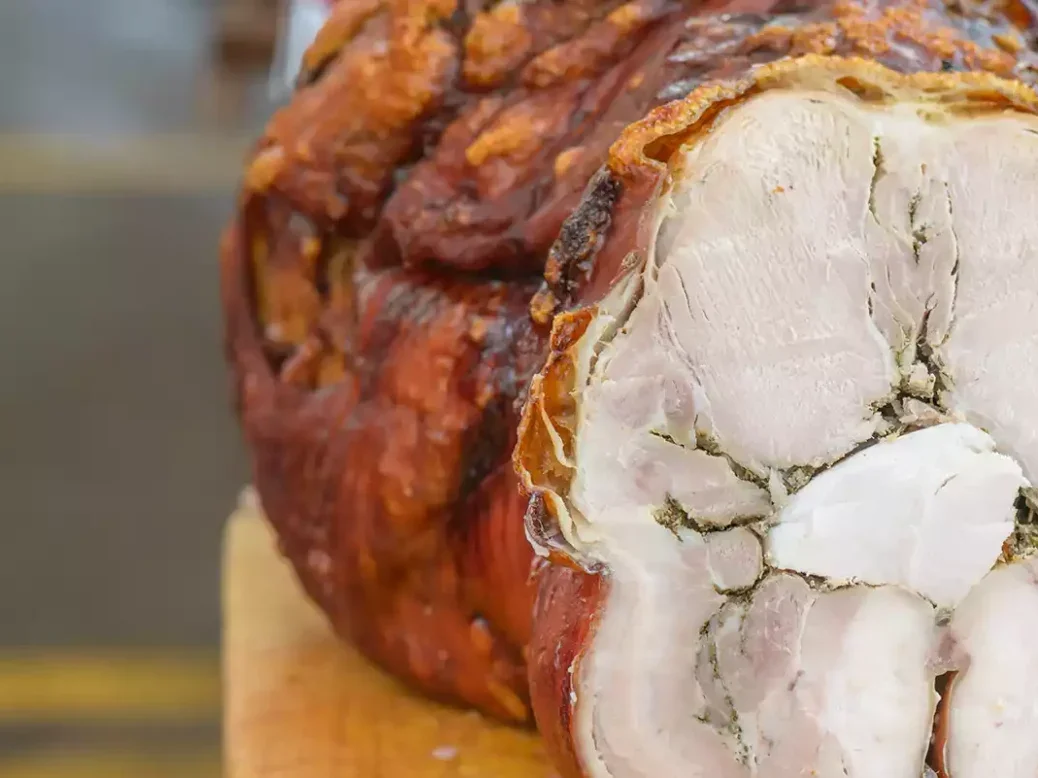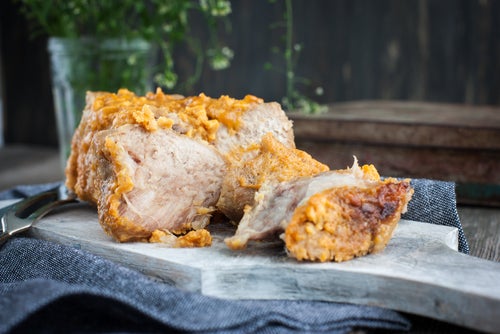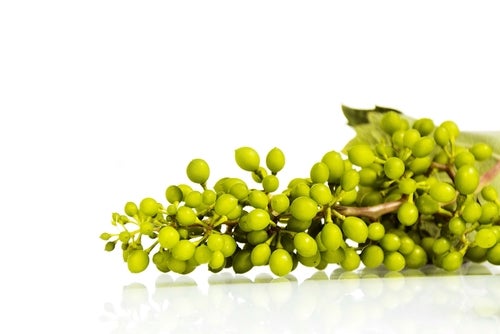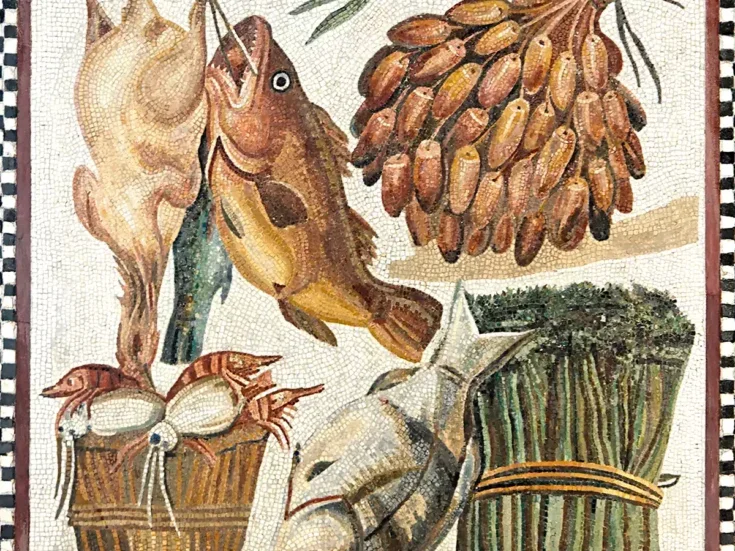
Porchetta is one of an ever-increasing number of regional dishes that has gone, if not quite global, then certainly globe-trotting, a phenomenon to which Italian cuisine seems particularly inclined. The evidence points to porchetta having originated in the town of Ariccia in Lazio, although there are inevitably counterclaimants—a notable one from Norcia in Umbria. From Ariccia, southeast of Rome, it spread not only to other parts of Italy, including the Veneto (porchetta Trevigiana), Umbria, Abruzzo, Le Marche, and southern Tuscany, but also to the US, taken there by Italian immigrants in the early 20th century.
It’s tempting to feel that this gone-viral mass-market effect must always diminish the story and authenticity of a recipe. But, aside from supermarket offerings, much of what is sold as porchetta today does retain the integrity of the traditional recipe, whether it’s slices clamped between thick slices of bread and sold from mobile trucks on the street and at every festival in Italy, porchetta served in restaurants, or porchetta prepared by butchers for customers to cook at home, albeit usually without the pig’s head.
Ariccia: The home of porchetta?
What the butcher is preparing is belly with the loin attached, which, once deboned, seasoned with salt, rested, seasoned again, with rosemary or fennel (according to region), garlic, and black pepper, is rolled tightly and tied all along its length, ready for long, slow roasting before a final period of resting and cooling. The result is succulent, cold meat—the lean loin having been kept moist and tender by the fatty belly—deeply flavored with spices and herbs and encased in a crisp, brown skin.
Ariccia’s claim on porchetta goes back at least to Roman times, when suckling pigs were offered as a sacrifice to the deities, notably the goddess of the harvest, Ceres, during I Cerealia, the major spring festival. During excavations in 1932, seated statues of divinities, one holding a suckling pig, were found in a temple in Casaletto in Ariccia (they are now in the National Museum of Rome).
According to Fondazione Qualivita (a non-profit organization that enhances and protects European quality food and wine), it is thought that the artisan skills of preparing porchetta were passed down from father to son for centuries in Ariccia because the Roman nobility spent their summers there and hunted there.
Cementing its claim, Arricia’s porchetta is the only one to have Protected Geographical Indication (PGI) status, which it won in 2011, and the town was the first in Italy to hold a porchetta festival. Its annual Sagra della Porchetta di Ariccia Autentica has been held on the first Sunday of September since 1950. This year’s (allowing for Covid) was the 72nd. Note the “Autentica” in the name. Other places hold longer festivals—Costano in Perugia devotes a week to its sagra, and Campli in Abruzzo, with the all-encompassing name of Sagra della Porchetta Italica, sets aside six days, but Costano only reached its 49th sagra this year, while Campli’s first was in 1964.
PGI status means rules. Porchetta di Ariccia applies to either a whole pig (intera) or the central part (tronchetta). After cooking and seasoning, these weigh, respectively, 27–45kg (60–100 pounds) and 7–13kg (15–29 pounds). The pigs must be female and be of the Landrace, Large White, or Pietrain breeds or their hybrids, and production must be within the municipality of Ariccia.
Deboning is by hand, as is the massaging to eliminate any excess salt after the salting and resting. The herb used is rosemary (not fennel as in Umbria and Le Marche) and cooking takes 3–6 hours at a temperature of 320– 536°F (160–280°C). Cooling lasts 5–15 hours during which time fat and excess liquid are eliminated and the rind gains its characteristic dark color.
Wherever the porchetta is from and is eaten, it’s popular served between slices of bread (panino con la porchetta), but is also served as a main course with simple side dishes, such as roast potatoes and a leaf salad, a green vegetable, or grilled vegetables. Less often, it’s reheated to serve hot.
The best wines to pair with porchetta
Pork is versatile when it comes to wine, pairing with both red and white, and porchetta is a dish that presents little in the way of competing flavorings and side dishes. The points to bear in mind are that the flavor of the pork flesh is more intense than usual, the texture of cold meat with fat is denser, and the seasoning of salt, pepper, garlic, and rosemary/fennel is quite assertive.
Whether the wine is white or red, a balancing assertiveness needs to come from acidity or some sort of tang that cuts through the meat. Whites can’t afford to be too light and neutral, but nor do they want to be too aromatic or fruit-driven. Varieties that have their own herbal inflection and a mineral character and/or almond nuttiness tend to work well: Greco di Tufo, for example from Feudi di San Gregorio; good Verdicchio, such as a Verdicchio di Matelica from Borgo Paglianetto; Etna Bianco, Soave Classico, and Vermentino.
Italy’s whites have much to offer, but they are not the only possibility. Among others are Rueda Verdejo, such as Bodegas Naia; Southern French blends, for example the rich but mineral-fresh Château Anglés La Clape Blanc 2023; and Chenin Blancs from Alheit in the Western Cape.
When it comes to red wines, powerful tannins and oak get in the way and, as well as needing some sort of tangy edge, red wines are better if they have a savory quality, rather than the intense fruit character of, for example, varietal Cabernet Sauvignon or Merlot. If that disappoints you, I would suggest Cabernet Franc from the Loire (Saumur Champigny or Saumur from Domaine Filliatreau, for example) or from high-elevation vineyards in South America—a wine such as Zuccardi Apelación Cabernet Franc from the Uco Valley.
Red grape varieties and appellations that generally work well, but notably in their less ambitiously concentrated, oaky forms, are Tuscan Sangioveses, Aglianico del Vulture, Langhe and Asti Nebbiolo, Barbera d’Alba, Trentino Schiava, Etna Rosso, Beaujolais crus (but Fleurie and Chiroubles less so), and Pinot Noir, including Sancerre and good Bourgogne. To recommended four reds I have enjoyed recently, all from the 2022 vintage: Cascina Alberta Barbera d’Alba, Cum Vineis Sclavis Schiava, Domaine de la Voûte des Crozes Côte de Brouilly, and Domaine Petit Pérou Morgon.
Other reds to consider are Greek wines from indigenous grape varieties grown at high elevations, Saperavi intended to be drunk young, and traditional, dry DOC Lambrusco, preferably Lambrusco Grasparossa di Castelvetro.






